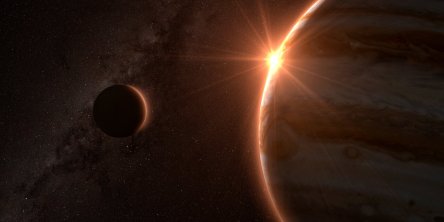Looking for easy, fun and free activities to fill your winter nights? Step outside and open your eyes to some spectacular upcoming astronomical events. Dec. 7: Jupiter at opposition The largest planet in the solar system lies opposite the sun in the sky and will be visible all night in the constellation Taurus. Dec. 8: Saturn near moon The ringed planet will appear close to the moon in the constellation Aquarius. Dec. 14-15: Geminid meteors; Jupiter and moon Normally one of the best meteor showers of the year, with 100-120 per hour, the Geminids will be somewhat obscured by the full moon. Meteors are caused by streams of cosmic debris that enter the Earth’s atmosphere. Also on Dec. 14, Jupiter will appear close to the 98%-illuminated moon in the constellation Taurus. Dec. 18: Mars near moon The red planet will appear close to the 92.3%-illuminated moon in the constellation Cancer. Dec. 22-23: Ursid meteors The last major meteor shower of the year peaks this night, from after sunset until moonrise. Under ideal conditions, as many as 10 meteors could be visible per hour. Dec. 25: Mercury at greatest elongation west The closest planet to the sun will appear at its farthest apparent distance west from the sun, an event known as the greatest elongation. It’s the best time to observe Mercury. Jan. 2-3: Quadrantids meteors Keep the New Year celebration going by viewing this meteor shower at its peak. With the moon only 11% full and set before the shower begins in earnest, the display will be visible from anywhere in the Northern Hemisphere with clear skies and little light...
IoT Phone Home
Smart Technologies
As the Internet of Things expands exponentially, astronomers and tech companies are fighting it out in the newly crowded radio spectrum. In the high desert of northern Chile, the Atacama Large Millimeter Array (ALMA) scans the night sky, its 66 high-precision antennas seeking out the faintest radio waves. Unfortunately, the frequencies ALMA depends on to gather valuable scientific data exist on a previously unallocated radio spectrum suddenly crowded by competing interests, including all those smart devices scattered throughout our homes. “There are no spectrum bottlenecks for dedicated Internet of Things systems yet,” Kevin Ashton, co-founder and former executive director of Massachusetts Institute of Technology’s Auto-ID Center, told Bloomberg BNA, “but we are seeing Wi-Fi services get maxed out, as there are only so many channels you can cram into the available spectrum.” “The extent to which the Internet of Things will be a threat to radio astronomy will depend upon whether the regulatory standards can be upheld in the face of the massive onslaught of lawyers funded by the private sector,” Carla Beaudet, RF Test & Measurement Engineer at National Radio Astronomy Observatory explains to Discover Magazine. “If the regulatory standards are upheld rather than modified every time somebody needs more spectrum, there will still be small windows of spectrum in which astronomers can observe.” Smart Spectrum Every smart device, from temperature savvy toasters to programmable thermostats, communicates via radio waves. Unfortunately, as the number of wired gadgets and intelligent contraptions multiplies, previously unobstructed frequencies are jammed with the chatter of clever toothbrushes and talkative televisions. While some bands are protected by the FCC – 1400 megahertz for hydrogen, for example – the rest of the spectrum gets shared by 29 services ranging from mobile phones to radio stations to military drones. As each...


